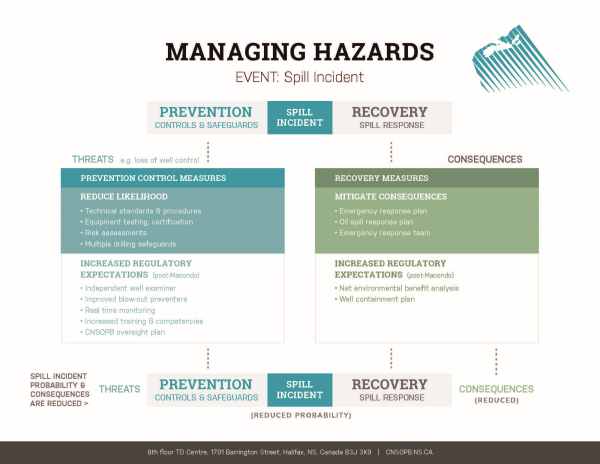Emergency Plans
Operators must submit emergency plans for us to review and accept prior to authorizing an activity. Plans to respond to potential health and safety emergencies and spills are required by legislation for all oil and gas activities conducted in the Canada-Nova Scotia offshore area.
Contingency Plans
A contingency plan addresses a specific emergency outcome from hazards, potential situations and events.
Operators are required to submit contingency plans before an authorization can be granted. Contingency plans should include measures to prevent, mitigate and respond to emergencies. We review the plans to ensure that they include items such as the duties and responsibilities of personnel, medical support, communications equipment/facilities, reporting and notification procedures and the appropriate contact information for responders and stakeholders. In addition, operators must test their contingency plans regularly to ensure effectiveness. In some cases, our team observes or participates in such simulations, to evaluate an operator's emergency procedures, preparedness and response.
Spill Response Plans
Operators must submit a spill response plan as part of our Activity Authorization process. This plan includes a risk assessment and outlines how an operator would respond to a variety of spill scenarios. Operators must also demonstrate that they have the necessary equipment in place and trained personnel prepared to respond to a spill. We verify that appropriate spill response plans are in place before issuing an authorization.
Net Environmental Benefit Analysis
Net Environmental Benefit Analysis, also known as a spill impact mitigation assessment, is an approach used by the oil and gas response community and stakeholders during oil spill planning and preparedness. It is used to compare the environmental benefits of potential response tools and develop a response strategy that will reduce the impact of a spill on the environment. A Net Environmental Benefit Analysis, or spill impact mitigation assessment, is one of the considerations used to select spill response tools that will effectively remove oil and will minimize the impact of the spill on the environment.
Operators are required to prepare a Net Environmental Benefit Analysis to assist in the development of their spill response plan. The Net Environmental Benefit Analysis is reviewed by us, in collaboration with Environment and Climate Change Canada’s National Environmental Emergencies Centre’s Science Table which includes Canada’s top experts in environmental protection and oil spill response from all levels of government, as well as other stakeholders from the oil spill response industry.
Approval of Dispersants
If a major emergency occurs and an operator was to consider the use of a dispersant, they would need to make the request to our Chief Conservation Officer for approval. Our Chief Conversation Officer would request that Environment and Climate Change Canada urgently convene the National Environmental Emergencies Centre’s Science Table. Once convened, these experts would evaluate the environmental pros and cons of using a dispersant based on the spill-specific scenario and the best available science to determine if using a dispersant would provide an overall net benefit to the environment. What this means is that the assessment would need to demonstrate that dispersant use for the specific instance will assist in minimizing the overall impacts to the environment and marine environment.
If it is determined that dispersants would be beneficial to mitigate the impact of the spill on the environment and marine life, dispersants would be approved for use. It should be noted that the Chief Conservation Officer can only authorize the use of dispersants that are legally approved for use in Canada by Environment and Climate Change Canada.
As part of the compliance oversight, we would closely monitor the operator’s actions to ensure the dispersant is being used appropriately, continues to be effective and has a net environmental benefit and that environmental protection remains paramount.
Emergency Response Team Drills and Exercises
Operators are required to complete emergency response drills and exercises. As part of our monitoring and compliance verification activities, we verify that exercises and drills are conducted as expected and in accordance with the operator’s management system commitments including measures for assessing and continually improving the emergency response plan.
Exercises and drills are conducted by operators, their personnel and contractors on the offshore installations or vessels and at their onshore office locations. The exercises and drills are conducted to test their response and readiness of internal and external resources during an emergency. An emergency response exercise typically involves the operator’s offshore workers located on the installation or vessel and staff that may be located at their onshore office. An emergency response exercise may also include mutual aid from external resources such as the Joint Rescue Coordination Centre, Canadian Coast Guard, other governmental departments/agencies and privately funded specialized emergency response service providers.
Our Role in an Operator's Emergency Response Exercise
As the regulator, we prepare for potential emergencies by participating and observing offshore emergency drills and exercises completed by operators. Our participation in an emergency response exercise allows us to observe and evaluate the operator on their response during the exercise. Some of our main objectives are evaluating an operator’s ability to implement a response command structure, exercise project specific response plans and execute response components such as plans, logistics and communications. We also simulate any decision making processes (e.g. use of dispersants) we are required to be a part of, and to act in our monitoring role as necessary to support the exercise.
